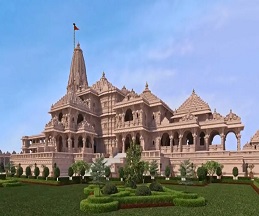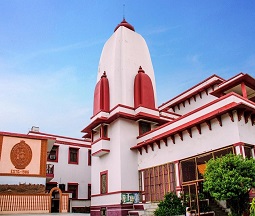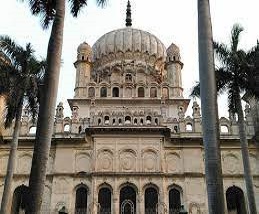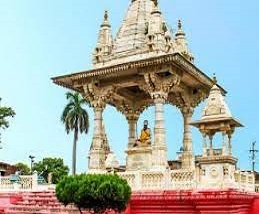Check out these amazing tour destinations in Ayodhya and make the most out of your next trip while getting associated with the best Travel agents in Ayodhya .

The birthplace of Lord Ram, Ramjanma Bhoomi, is revered by Hindus as a place of great religious significance. It is also famous as one of india’s most sacred places and witnessing the arrival of millions of pilgrims and tourists all around the year. Well, apart from Ramjanma Bhoomi, there are various other places that are worth a visit on your next visit to ayodhya.

During the time of the Ramayan, Sita's royal kitchen was known as Sita ki Rasoi; later, it was converted into a temple. Currently, it is one of the most sought after destinations in Ayodhya and it is said that Mata Sita used to cook for Lord Rama here only.

The Tulsi Smarak Bhawan Museum, which was established in 1969 to honor the revered poet-saint Goswami Tulsidas Ji, is a location brimming with old-world literature and artifacts. You can visit this place for more details on Ramayana.

In the city of Ayodhya, there is a stunning park called Ramkatha Park. There are many temples and other religious sites in the city, and these locations can occasionally be very crowded. So, you can also pay a visit here to know more about Lord Rama.

In Ayodhya, there is a temple called Raja Mandir that has ties to numerous Ramayan-era myths. Every year, thousands of devotees of lord ram visit this temple. On your next visit to Ayodhya, you can certainly visit this destination.

Mani Parbat, a small hillock in Kami Ganj, Ayodhya, is very significant to Hinduism and is often been visited by millions of spiritual tourists every year. Well, you can learn a lot regarding the life of Lord Rama and his childhood at this destination.

The magnificent Moti Mahal was erected in the year 1743 A.D. It is located outside of Ayodhya in the district of Faizabad and was the residence of the Queen at the time, Begum Unmatuzzohra Banu, the wife of Nawab Suja-Ud-Daula.

The Choti Chawni is a magnificent building in Ayodhya made of white marble and crafted in a way that distinguishes it from other buildings nearby. This will help you to learn a lot regarding the ancient era of the city ayodhya and related aspects.

The tomb of Begum Unmatuzzohra Bano, the wife of Nawab Suja-ud-Daula, is known as Bahu Begum ka Maqbara. Nawab Suja-ud-Daula erected this structure, one of the tallest in the area, as a memorial to his wife. Visit this place for more information regarding the Mughal era.

The River Sarayu, which flows through the city of Ayodhya, is revered greatly, and there are several ghats nearby that house different temples and places of worship. You will certainly feel a different aura and vibe while visiting this place.

The Guptar Ghat in Faizabad is a short distance from Ayodhya by car, and on the ghat is a stunning temple called Chakra Harji Vishnu Temple. This temple has a huge significance for all the devotees of the Lord Vishnu and Lord Shiva.

The Kanak Bhavan, which is devoted to Lord Ram and Sita, is important to Hinduism. The shrine, one of Ayodhya's most popular destinations, is a fine example of exquisite temple architecture. Visit this place for more information about the life of Lord Rama.

Hanuman Garhi is a temple in Ayodhya that is dedicated to Lord Hanuman. The location is highly revered by Hindus, and many people travel there each year. Visit this place to learn about the life of Lord Hanuman and his devotion to Lord Rama.

Ayodhya's Tulsi Udyan is a well-known garden. Previously, the area was known as Victoria Park, and it featured a statue of Queen Victoria in the park's middle. The place has a big significance among the devotees of Lord Vishnu and Lord Rama.

.This temple is very important from a religious perspective and is said to have endured numerous natural disasters. It is also claimed that this was the only temple to have endured until the time of Vikramaditya and highly sought after by the locals here.

Near Naya Ghat in Ayodhya, there is a shrine to Lord Ram called Treta ke Thakur. According to mythloogists, Lord Ram performed the Ashvamedha Yajna here, making it a very sacred site for Hindus and everyone following Lord Rama.

Ayodhya's Gulab Bari is a stunning and meticulously kept rose garden. Surrounding Suja-Ud-tomb Daula's , this garden is known for its amazing eauty and roses. Every year, thousands of visitors come here to revisit the centuries old mughal era.

The Guptar Ghat, which is located on the banks of the River Sarayu, is a sacred site for Hindus. According to legend, Lord Ram used to meditate here and enter a Jal Samadhi in the river before attaining vaikuntha.

The Dashrath Bhawan is a building in Ramkot that is in the heart of the city. King Dashrath, the founder of Ayodhya and the father of Lord Ram, lived in this house originally. So, the place got some good significance among every hindu devotee.

The well-known Tulsi Smarak Bhawan is a shrine to Goswami Tulsidas ji, a revered saint and poet. The Ayodhya Research Center, a group that investigates the historical significance of Ayodhya in the literary, spiritual, and cultural senses, is housed in the Bhawan.